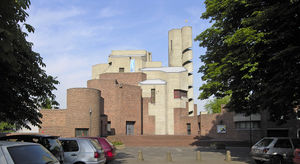
Gottfried Böhm
Encyclopedia

Germany
Germany , officially the Federal Republic of Germany , is a federal parliamentary republic in Europe. The country consists of 16 states while the capital and largest city is Berlin. Germany covers an area of 357,021 km2 and has a largely temperate seasonal climate...
architect
Architect
An architect is a person trained in the planning, design and oversight of the construction of buildings. To practice architecture means to offer or render services in connection with the design and construction of a building, or group of buildings and the space within the site surrounding the...
.
Böhm was born into a family of architects in Offenbach, Hessen. His father, Dominikus Böhm
Dominikus Böhm
Dominikus Böhm was a German architect specializing in churches. He build churches in Cologne, the Ruhr area, Swabia, and Hesse...
, is renowned for having built several churches throughout Germany. His grandfather was also an architect. After graduating from Technical University of Munich
Technical University of Munich
The Technische Universität München is a research university with campuses in Munich, Garching, and Weihenstephan...
in 1946, he studied sculpture
Sculpture
Sculpture is three-dimensional artwork created by shaping or combining hard materials—typically stone such as marble—or metal, glass, or wood. Softer materials can also be used, such as clay, textiles, plastics, polymers and softer metals...
at a nearby fine-arts academy. After 1947, Böhm worked for his father until the latter's death in 1955. Böhm later took over the firm. During this period, he also worked with the "Society for the Reconstruction of Cologne
Cologne
Cologne is Germany's fourth-largest city , and is the largest city both in the Germany Federal State of North Rhine-Westphalia and within the Rhine-Ruhr Metropolitan Area, one of the major European metropolitan areas with more than ten million inhabitants.Cologne is located on both sides of the...
" under Rudolf Schwarz
Rudolf Schwarz (architect)
Rudolf Schwarz was a German architect known for his work on Kirche St. Fronleichnam, Aachen. He also played a decisive role in the reconstruction of Cologne after the Second World War. After conducting Cologne's reconstruction authority between 1947 and 1952 he contributed to the rebuilding of the...
. In 1951 he traveled to New York City
New York City
New York is the most populous city in the United States and the center of the New York Metropolitan Area, one of the most populous metropolitan areas in the world. New York exerts a significant impact upon global commerce, finance, media, art, fashion, research, technology, education, and...
, where he worked for six months in the architectural firm of Cajetan Baumann. While traveling in America he met two of his greatest inspirations, German architects Ludwig Mies van der Rohe
Ludwig Mies van der Rohe
Ludwig Mies van der Rohe was a German architect. He is commonly referred to and addressed as Mies, his surname....
and Walter Gropius
Walter Gropius
Walter Adolph Georg Gropius was a German architect and founder of the Bauhaus School who, along with Ludwig Mies van der Rohe and Le Corbusier, is widely regarded as one of the pioneering masters of modern architecture....
.
In the following decades Böhm constructed many buildings around Germany, including churches, museums, civic centers, office buildings, homes, and apartments. He has been considered to be both an expressionist
Expressionism
Expressionism was a modernist movement, initially in poetry and painting, originating in Germany at the beginning of the 20th century. Its typical trait is to present the world solely from a subjective perspective, distorting it radically for emotional effect in order to evoke moods or ideas...
and post-Bauhaus
Bauhaus
', commonly known simply as Bauhaus, was a school in Germany that combined crafts and the fine arts, and was famous for the approach to design that it publicized and taught. It operated from 1919 to 1933. At that time the German term stood for "School of Building".The Bauhaus school was founded by...
architect, but he prefers to define himself as an architect who creates "connections" between the past and the future, between the world of ideas and the physical world, between a building and its urban surroundings. In this vein, Böhm always envisions the color, form, and materials of a building in relationship with its setting. His earlier projects were done mostly in molded concrete, but more recently he has begun using more steel and glass in his buildings, due to the technical advancements in both materials. His concern for urban planning
Urban planning
Urban planning incorporates areas such as economics, design, ecology, sociology, geography, law, political science, and statistics to guide and ensure the orderly development of settlements and communities....
is evident in many of his projects, again showing his concern for "connections".
Böhm won the Grande Medaille d'Or de l'Academie d'Architecture, the Fritz Schumacher Preis in Hamburg
Hamburg
-History:The first historic name for the city was, according to Claudius Ptolemy's reports, Treva.But the city takes its modern name, Hamburg, from the first permanent building on the site, a castle whose construction was ordered by the Emperor Charlemagne in AD 808...
(1985), and the Pritzker Architecture Prize
Pritzker Prize
The Pritzker Architecture Prize is awarded annually by the Hyatt Foundation to honour "a living architect whose built work demonstrates a combination of those qualities of talent, vision and commitment, which has produced consistent and significant contributions to humanity and the built...
(1986).

